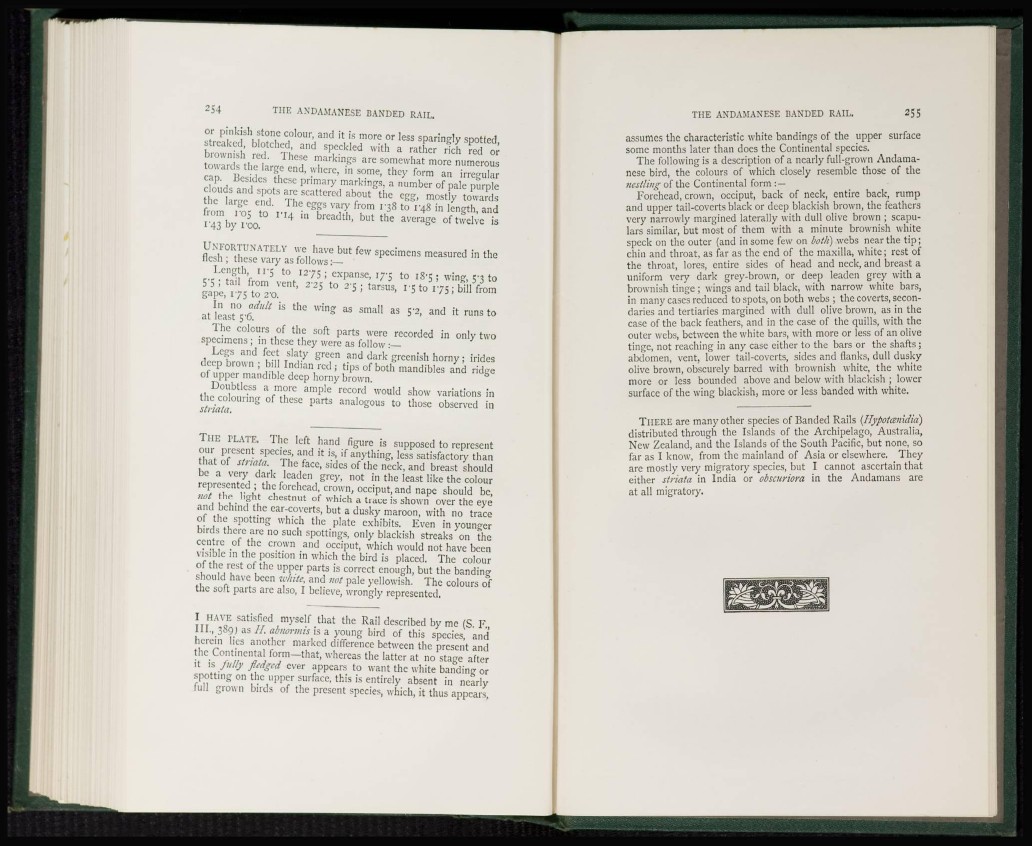
or pinkish stone colour, and it is more or less sparingly spotted,
streaked, blotched, and speckled with a rather rich red or
brownish red. These markings are somewhat more numerous
towards the large end, where, in some, they form an irregular
cap. Besides these primary markings, a number of pale purple
clouds and spots are scattered about the egg, mostly towards
the large end. The eggs vary from 138 to 1/48 in length, and
from IT>5 to L14 in breadth, but the average of twelve is
1-43 by 1'00.
UNFORTUNATELY we have but few specimens measured in the
flesh ; these vary as follows:—-
Length, 115 to 1275 ; expanse, 17-5 to i8'5 ; wing, 5-3 to
5-5 ; tail from vent, 225 to 2'5 ; tarsus, 15 to 175; bill from
gape, 175 to 2'o.
In no adult is the wing as small as 5'2, and it runs to
at least 5'6.
The colours of the soft parts were recorded in only two
specimens ; in these they were as follow :—
Legs and feet slaty green and dark greenish horny ; irides
deep brown ; bill Indian red ; tips of both mandibles and ridge
of upper mandible deep horny brown.
Doubtless a more ample record would show variations in
the colouring of these parts analogous to those observed in
striata.
THE PLATE, The left hand figure is supposed to represent
our present species, and it is, if anything, less satisfactory than
that of striata. The face, sides of the neck, and breast should
be a very dark leaden grey, not in the least like the colour
represented ; the forehead, crown, occiput, and nape should be,
not the light chestnut of which a trace is shown over the eye
and behind the ear-covcrts, but a dusky maroon, with no trace
of the spotting which the plate exhibits. Even in younger
birds there are no such spottings, only blackish streaks on the
centre of the crown and occiput, which would not have been
visible in the position in which the bird is placed. The colour
of the rest of the upper parts is correct enough, but the banding
should have been white, and not pale yellowish. The colours of
the soft parts are also, I believe, wrongly represented.
I HAVE satisfied myself that the Rail described by me (S F
I I I , 380.) as H. abnormis is a young bird of this species and
herein l,cs another marked difference between the present and
the Continental form-that, whereas the latter at no stage after
it is, fully fledged ever appears to want the white banding or
spotting on the upper surface, this is entirely absent in nearly
lull grown birds of the present species, which, it thus appears
assumes the characteristic white bandings of the upper surface
some months later than does the Continental species.
The following is a description of a nearly full-grown Andamanese
bird, the colours of which closely resemble those of the
nestling oi the Continental form : —
Forehead, crown, occiput, back of neck, entire back, rump
and upper tail-coverts black or deep blackish brown, the feathers
very narrowly margined laterally with dull olive brown ; scapulars
similar, but most of them with a minute brownish white
speck on the outer (and in some few on both) webs near the tip;
chin and throat, as far as the end of the maxilla, white; rest of
the throat, lores, entire sides of head and neck, and breast a
uniform very dark grey-brown, or deep leaden grey with a
brownish tinge ; wings and tail black, with narrow white bars,
in many cases reduced to spots, on both webs ; the coverts, secondaries
and tcrtiaries margined with dull olive brown, as in the
case of the back feathers, and in the case of the quills, with the
outer webs, between the white bars, with more or less of an olive
tinge, not reaching in any case cither to the bars or the shafts ;
abdomen, vent, lower tail-coverts, sides and flanks, dull dusky
olive brown, obscurely barred with brownish white, the white
more or less bounded above and below with blackish ; lower
surface of the wing blackish, more or less banded with white.
THERE are many other species of Banded Rails (Hypotcenidid)
distributed through the Islands of the Archipelago, Australia,
New Zealand, and the Islands of the South Pacific, but none, so
far as I know, from the mainland of Asia or elsewhere. They
are mostly very migratory species, but I cannot ascertain that
either striata in India or obscuriora in the Andamans are
at all migratory.